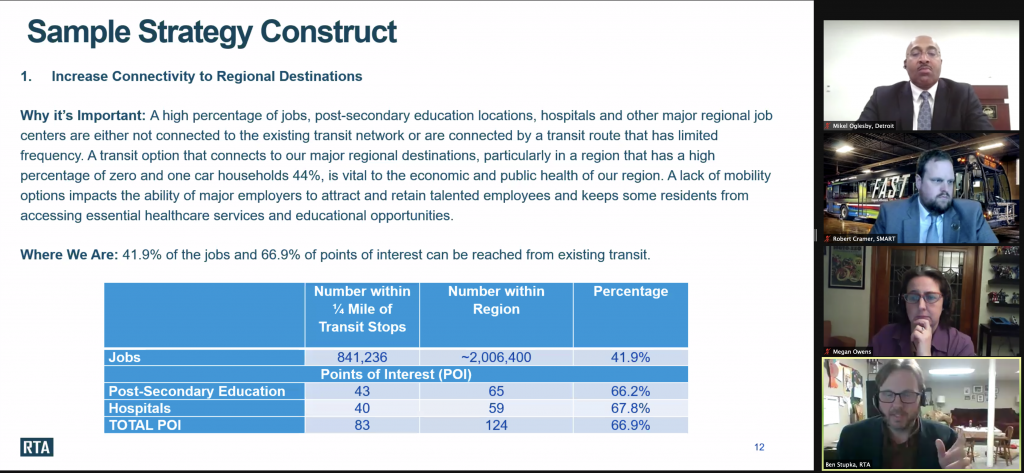What If We Can’t Wait? Public-Private Partnership Solutions for Infrastructure
Last week’s State of Transit, which followed Governor Gretchen Whitmer’s State of the State address the day before, involved the first public presentation from Southeast Michigan’s Regional Transit Authority (RTA) on their game plan. Or perhaps their lack of a game plan?
Detroit’s own Transportation Riders United— for which, full disclosure, I have done a small amount of paid work in the past around advocacy and strategic communications- has been a loyal supporter of RTA proposals past and present. The RTA’s Ben Stupka, who replaced Matt Webb after he departed for the private sector, presented about the timeline. Next year, inshallah, we will go back to the ballot box. Hopefully the voters will approve it this time! No discussion as of yet whether to drop Macomb County, the 800,000-strong, Trump-proud, strip-malled, vinyl-sided suburbs to the northeast of Detroit proper. This would require modifications to the RTA enabling legislation.
It would be onerous given the anti-infrastructure Republican legislature in Lansing. But it may be possible, especially given new, pro-transit Oakland County Executive Dave Coulter, who replaced the late, awful Lewis Brooks Patterson.
But is it enough? Are there, mayhap, other ways to, uh, punch this ticket? What if the private sector put some skin in the game? How much skin? How much game? Would it be worth looking at a public-private partnership? Or could private industry simply chip in to market the ballot initiative? Could private capital match public capital in some meaningful way? Is there something we can do now instead of wait for what may well be another failure of the RTA next year?
These are some of the questions I’m trying to answer as part of my MBA capstone research. This article looks at public-private partnership specifically.
What Is A Public-Private Partnership?
A Public-Private Partnership, also variously known as a PPP or a 3P, is a business strategy used to get something done that necessarily enlists the private sector and the public sector working together. PPP’s have always been around in some format, but the terminology is relatively recent: a meta-analysis of academic literature shows explosive growth in the interest of PPP’s around the turn of the new millennium. They’re increasingly popular in what I call the Golden Age of Austerity, which arguably began in the era of Fear City in New York in the late 1970’s. Ironically, New York’s own budgetary issues were largely the fault of Robert Moses’s decades-long bankrupting of public infrastructure in the pursuit of the motorcar– but that’s a story for another day.
At their worst, PPP’s are a euphemism for “figuring out a way to turn the taxpayer into a spigot of cash for private industry.” They can be terrible deals for taxpayers and great deals for private companies– see Stephanie Farmer’s excellent 2014 article, “Cities as Risk Managers: The Impact of Chicago’s Parking Meter P3 on Municipal Governance and Transportation Planning.” Indeed, the Chicago parking meter debacle was so bad that it is studied as examples of how not to do PPP’s– or municipal governance in general.
The rationalization for PPP
At their best, though, they can take pair private sector’s speed and quest for economic efficiency and optimization with the public sector’s lower cost of capital (compare negative-yielding federal debt, for example, to a company like Tesla having to borrow cash at rates as high as 14%*). Obviously, this is most important in cases where something has to get done to serve, say, all citizens– because a private company on its own would not do something like develop a transit system, since no transportation system are really profitable (Amtrak in the northeast, the NYC subway, and the Hong Kong metro, plus maybe a few more than exceed 100% FRR).
Risk transfer is another critical element. Again– if done correctly. I think risk should be less of an issue when talking about vital infrastructure. But it’s come up in a lot of literature. One source suggested that the transfer of risk can represent more than half of the cost savings in a PPP project (Wang, 2017: 304-305).
* – WACC estimated from balance sheet data 2015-2019.
What is not a PPP?
Well, there’s no great answer to this question. Most PPP’s are billed as such, but the things that aren’t may still seem PPP-ish. If a city government provides a no-bid contract to a private company to perform a service, isn’t this a PPP? Or is it just public procurement done badly? There’s not really a good delineation here. Governments will contract out to the private sector for work for any of a few reasons. Most apparently, this is done where governments lack the in-house staff capability to do something. Onboarding new staff is expensive, and government hiring procedures are often far more onerous than hiring procedures in the private sector. Getting approval to create a federal position, for example, requires layers and layers of approval, and can be a huge pain in the ass. This makes it easier to contract out.
Another example is where work is so infrequent that it doesn’t make sense to hire permanent staff to do it. Let’s say your city has a bridge that it has to replace– once. It has one or two engineers on staff who have enough staff time and expertise to serve as liaisons. But they can’t manage it themselves, because it’s a huge project that requires deep expertise but also construction logistics. Also, remember the risk thing? Public sector officials pass off projects like this in many cases so they won’t be held liable if something goes wrong. (This is perhaps foolish, because people will usually hold the people in power accountable regardless of whose fault it is).

Considering budgetary bloat from outsourcing
The City of Chicago contracting with a defense contractor to install and manage its new CTA payment system? Not really sure. But one thing is for sure– it’s expensive. And, as you can probably imagine, the budgetary bloat that comes to be associated with this kind of contracting edges skyward the higher you go in government. “The federal contracting division in Deloitte is just so vomit-inducing,” one of my interviewees said in a discussion on the subject. It’s just dudes who hang out at the Arlington Country Club every weekend and write each other checks.”
Surprisingly, my interviews with Detroit city staff and planners indicate that, while there is a lot of transfer of wealth to the private sector, comparatively little of it seems to be in government contracting. This came up a few years ago when I interviewed Ryan Friedrichs, who was then managing an office whose purpose was to basically shepherd philanthropic capital into the city. Friedrichs, who has now left the public sector for the dark side (working for Stephen Ross himself at Related– we won’t hold it against Ryan, though, because he’s a good guy), emphasized the value of taking advantage of the prevalence and flexibility of philanthropic capital, suggesting that it was a resource that was there to be used, as opposed to one that might threaten the agency of the public sector.
In other words, private grants exist because private philanthropic capital exists. That doesn’t mean that the city government is losing by not funding stuff itself. Especially if it lacks the budgetary resources to do it in the first place.
Conclusions
I’m not able to correct the issue of broke city government because it’s like the fricking Augean Stables. Do we need more taxes on wealthy people? Yeah. Do we need to stop subsidizing billionaires? Also yes. Unfortunately, I can’t change these things right now. I am able to propose real, ground-level solutions that might actually work, though. And thus the research into the feasibility of PPP for transit investment.
In the coming weeks, I’ll be writing up more about talking with folks from the RTA and beyond. These will be posted to my page on mobility research.




